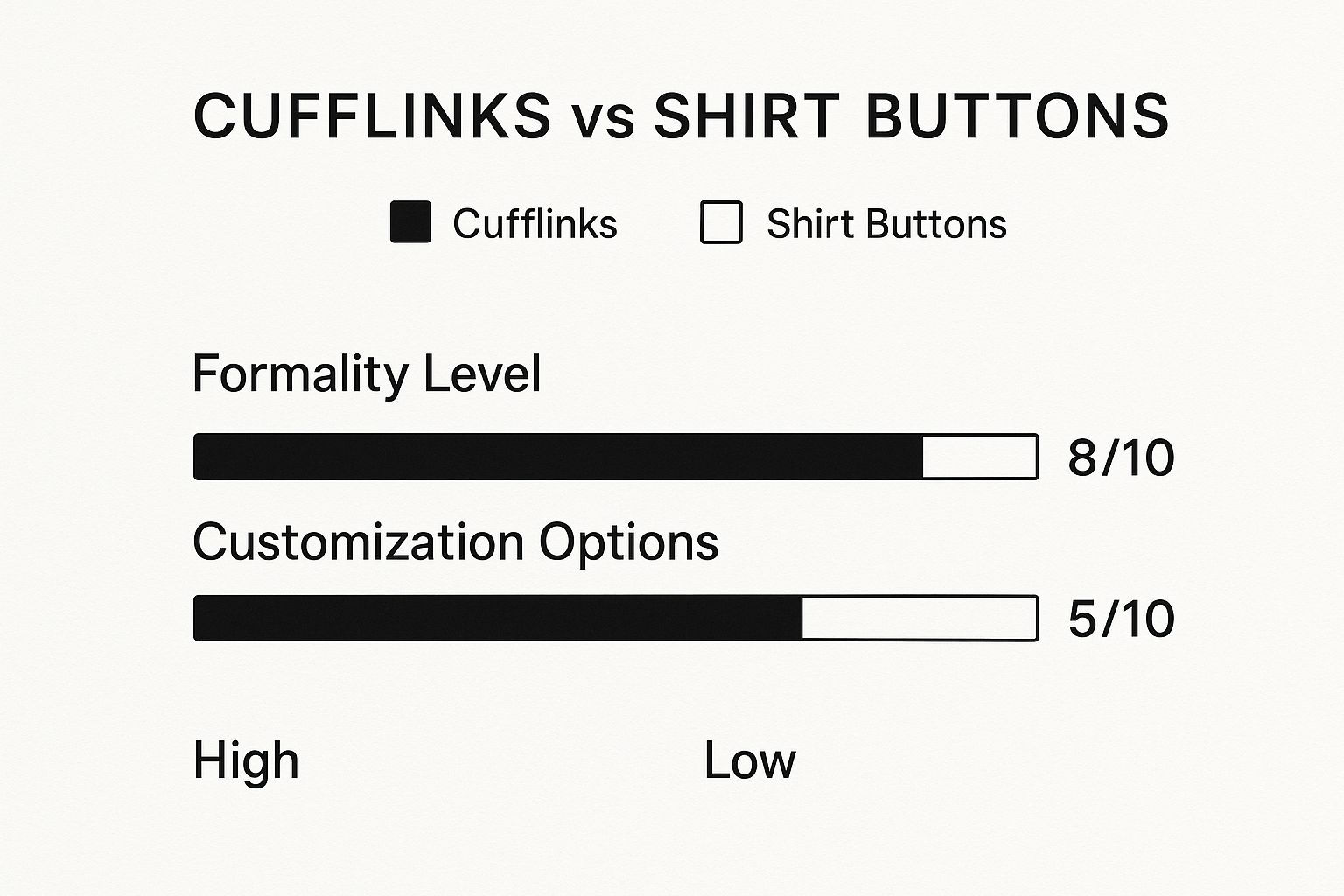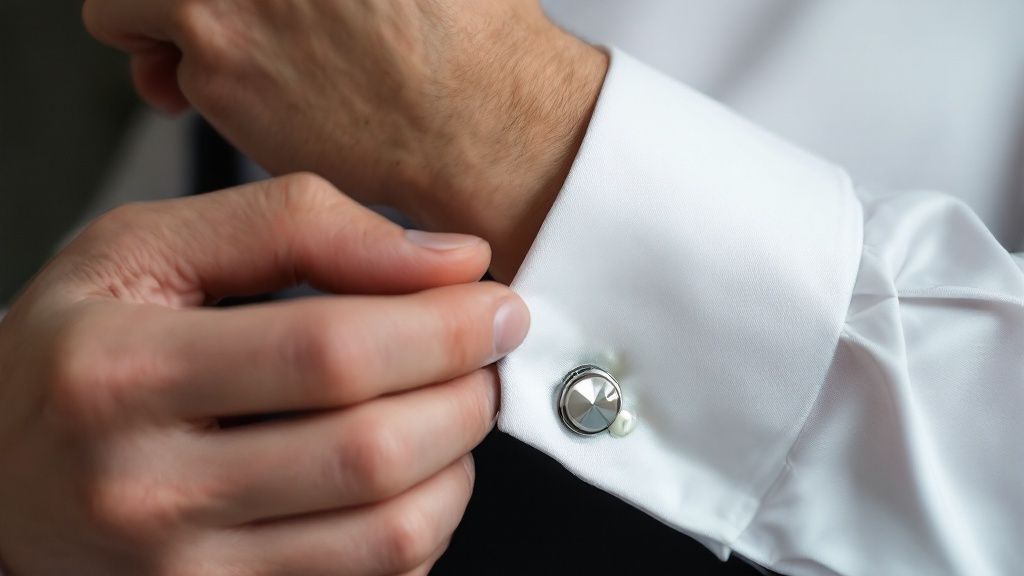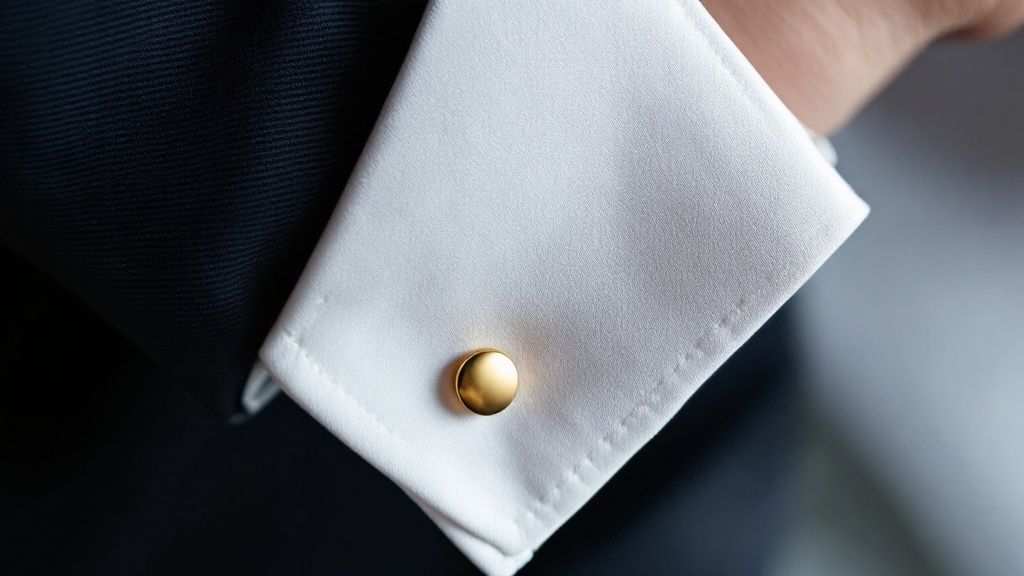How to Wear Cufflinks: Style Tips for Every Occasion
- seanmawhinney
- May 3
- 11 min read
The Cufflink Fundamentals: Styles That Make a Statement
Cufflinks: small details that can make a big impact on your personal style. Before learning how to wear them, let's explore the diverse world of cufflink styles. Understanding each type is key to making a statement.
Cufflink Styles: A World of Options
Cufflinks aren't a one-size-fits-all accessory. Different styles offer unique blends of functionality and aesthetics.
Bullet Back Cufflinks: Known for their simple design, bullet back cufflinks feature a toggling post. This practical design makes them popular for everyday wear.
Whale Back Cufflinks: Similar to the bullet back, the whale back cufflink has a "whale tail" that flips flat. This secure closure is remarkably easy to use.
Chain Link Cufflinks: Chain link cufflinks connect two decorative faces with a short chain. This style adds a subtle, classic touch to both sides of the cuff.
Fixed Backing Cufflinks: Fixed backing cufflinks, with no moving parts, require more effort to put on. Their sleek design is ideal for minimalist looks. For example, a simple knot or bar adds understated sophistication.
From the boardroom to a black-tie gala, these styles suit a range of preferences and occasions. Choosing the right style involves balancing ease of use with the desired aesthetic.
Materials and Perception: Making the Right Impression
The material of your cufflinks significantly influences perception. Sterling silver projects classic refinement, while gold exudes luxury. Stainless steel offers durability and a modern edge. Novelty cufflinks, made from materials like silk or featuring unique designs, inject personality while maintaining professionalism. Cufflinks can be more than functional; they can be conversation starters and reflections of your individuality. For more style tips, check out this article: How to master your style choices.
Cufflinks have seen a resurgence in formal wear, especially in Europe. Europe represents 33% of the global cufflink market, driven by strong professional attire traditions. While men currently account for 85% of cufflink usage, younger demographics are increasingly embracing this accessory. Find more detailed statistics here. Proper care ensures the longevity of your cufflinks. Consider these tips for other valuable items: How to Care for Oak Living Room Furniture.
Comparing Cufflink Styles: A Quick Guide
The following table compares various cufflink styles, highlighting their ease of use and suitability for different occasions:
This table summarizes key characteristics of each cufflink type, helping you choose the best one for your needs. Bullet back and whale back offer convenience, while chain link and fixed backing provide more formal aesthetics.
The data chart below visualizes ease of use and security for different cufflink styles.

As the data chart illustrates, bullet back cufflinks offer high ease of use and security, making them a versatile choice. Fixed backing provides high security but lower ease of use, while chain link cufflinks are less secure. This information allows you to select the best cufflink style for your individual needs.
Finding Your Perfect Canvas: Shirts Made for Cufflinks
The right shirt can truly elevate cufflinks. They transform from simple fasteners into powerful style statements. This all begins with understanding French cuffs, the quintessential cufflink companion. Authentic double (or French) cuffs offer a unique drape and structure unmatched by single-button cuffs. Their distinctive fold-over design provides the perfect backdrop for showcasing your chosen cufflinks.
Identifying Quality in French Cuffs
Master tailors stress the importance of quality construction in French cuffs. Look for dense, even stitching to reinforce the cuff's structure and ensure durability. The cuff thickness should be substantial enough to hold its shape, yet flexible enough for comfortable wrist movement. A well-made French cuff will beautifully frame your cufflinks and maintain a polished look all day. For more on available products, check out Our Product Sitemap.
Navigating the World of Convertible Cuffs
Convertible cuffs offer versatility, allowing you to wear both cufflinks and buttons. This adaptability does come with trade-offs, however. While offering a practical option for transitioning between formal and casual settings, convertible cuffs sometimes lack the elegant drape of a true French cuff. This can impact the overall presentation, especially with heavier or more ornate cufflinks. Choosing between French and convertible cuffs depends on how often you wear cufflinks and your typical required level of formality.
The Interplay of Sleeve Length, Jacket, and Cufflinks
The relationship between sleeve length, jacket proportions, and cufflink visibility is a subtle yet critical element of refined style. Ideally, your shirt cuff should extend approximately half an inch beyond your jacket sleeve. This allows your cufflinks to peek out, adding a sophisticated touch without being overpowering. This balance ensures your cufflinks enhance your overall look without dominating it.
Achieving the Perfect Fit: Insights from Bespoke Shirtmakers
Bespoke shirtmakers understand the importance of comfortable wrist movement throughout the day. A well-fitted French cuff should allow for easy flexion and extension of the wrist without constriction. This requires careful consideration of both cuff circumference and buttonhole placement. A tailored fit not only enhances comfort but also keeps your cufflinks secure, showcasing their design. This attention to detail distinguishes a truly well-dressed individual. Finding the right shirt involves balancing aesthetics with practical considerations like comfort and ease of movement.

Mastering the Art: How to Wear Cufflinks Like a Pro
Wearing cufflinks is more than just a functional necessity; it's a statement of style. The process begins with preparing your French cuffs. Ensure they're crisp and neatly folded back to create a smooth surface. This careful preparation is the foundation for proper cufflink alignment, a key sign of attention to detail. This ensures your cufflinks look their best and function flawlessly.
Achieving Seamless Insertion and Alignment
Quickly and efficiently fastening your cufflinks, particularly with a single hand, is a skill worth mastering. It's a delicate balance between holding the cuff taut and guiding the cufflink post through the buttonholes. Strive for perfect alignment, so the decorative faces of the cufflinks rest flat against your cuff. This small detail contributes to a polished and sophisticated look. Mastering this technique transforms a potentially cumbersome task into a display of effortless elegance.
Troubleshooting Common Cufflink Challenges
Occasionally, even seasoned cufflink wearers encounter difficulties. Bullet backs can sometimes be resistant, requiring a gentle but firm push to secure the toggle. Whale backs, though typically easy to use, may occasionally slip or loosen. Understanding how to address these common issues is essential for making this daily ritual a confident habit, not a source of frustration. Practice makes these adjustments seamless and intuitive.
For instance, a slightly loose whale back can be tightened by gently squeezing the "tail" for a more secure grip. A stiff bullet back can be eased with a touch of lubricant or by carefully manipulating the toggle. Menswear experts suggest that subtle adjustments in positioning can have a significant impact. A slight change in angle or tightness can greatly affect both comfort and appearance, especially for those with larger wrists or heavier cufflinks. Interestingly, Millennials are influencing cufflink trends, with their focus on authenticity driving a 6.29% CAGR (2024-2028), according to Technavio. This demographic’s social media presence has popularized unique styling approaches. Learn more about Millennials' Impact on the Cufflink Market.
Tailoring Your Approach to Wrist Size and Cufflink Weight
Adjusting your cufflink placement based on your wrist size and the weight of the cufflinks is important. Larger wrists might require a slightly tighter fit to prevent slippage. Heavier cufflinks, conversely, might benefit from a slightly looser fit to avoid discomfort and strain on the fabric. This balance ensures both a secure and comfortable feel.
Elevating Your Style with Precise Positioning
The position of your cufflinks can subtly communicate your personal style. Positioning them closer to the cuff's edge offers a modern feel, while a centered placement evokes a more classic aesthetic. Experimenting with these variations allows you to express your individuality within this timeless menswear tradition. This attention to detail elevates cufflinks beyond simple fasteners, transforming them into nuanced expressions of personal style. This is the mark of a truly well-dressed individual. Mastering the art of wearing cufflinks is ultimately about more than just practicality; it's about showcasing your meticulousness and expressing your personal style with confidence.
Occasion-Perfect Styling: Beyond Basic Cufflink Rules

Knowing how to wear cufflinks correctly goes beyond the simple mechanics. It involves understanding the subtle interplay of style and occasion. This knowledge allows you to elevate your presentation through these small but impactful accessories. Let's explore the unwritten rules of cufflink etiquette that distinguish the truly refined dresser.
Metal Tone Coordination: The Hallmark of a Polished Look
One fundamental principle of sophisticated dressing is metal tone coordination. This means ensuring your cufflinks harmonize with other metal accents in your outfit. Think about your watch, belt buckle, or rings. For instance, silver cufflinks naturally complement a silver watch and belt buckle. This creates a sense of visual unity.
This attention to detail projects a polished and coordinated image. It shows you understand the importance of visual harmony in your attire.
Statement Pieces: Knowing When to Shine
Statement cufflinks offer a chance to express personality and flair. However, choosing the right moment is essential. These bolder designs are well-suited for occasions where you want to stand out, such as a festive gathering or a networking opportunity.
For more formal or somber events, like a business meeting or a funeral, understated, classic designs are more appropriate. This shows respect for the setting while still demonstrating your attention to detail.
Seasonal Material Selection: Adapting to the Occasion
Cufflink materials also play a role in aligning with the season and overall outfit tone. Mother-of-pearl cufflinks, for example, offer a cool, refreshing touch for summer events. In contrast, onyx provides warmth and sophistication in winter.
This awareness of seasonal appropriateness adds another layer of refinement to your style choices. For further exploration, you might be interested in: Exploring cufflink designs.
Wedding Etiquette: Balancing Sentiment and Style
Weddings provide a unique opportunity to showcase commemorative or personalized cufflinks. The key is to strike a balance between sentiment and sophistication. Engraved initials or a significant date can add a personal touch.
However, overly ornate or novelty cufflinks might clash with the formality of the occasion. Choosing cufflinks that combine personal meaning with elegant design demonstrates thoughtful consideration.
Cultural and Professional Nuances: Showing Respect Through Style
Cufflink choices can also convey respect in different cultural and professional settings. In some cultures, certain symbols or materials carry specific meanings. Certain professions may also have unspoken dress codes that influence appropriate cufflink styles.
Being mindful of these nuances demonstrates cultural sensitivity and professionalism. This awareness helps you navigate diverse social and professional environments with confidence.
Navigating Formal Events with Confidence: A Decision Matrix
The following table, "Cufflink Styling Guide by Occasion," provides a helpful overview of appropriate cufflink choices for different events:
This table offers a quick guide for choosing the right cufflinks for various formal events. Considering the occasion, recommended style, materials, color considerations, and matching elements will help you select cufflinks that enhance your overall presentation. This attention to detail showcases your understanding of style etiquette. Mastering cufflinks is about using these small details to express your personal style and respect for the occasion.
Breaking the Rules: Modern Cufflink Expressions

While tradition provides a foundation for wearing cufflinks, modern style is all about innovation. Forward-thinking professionals are finding new ways to express themselves by reimagining how cufflinks can be worn, all while maintaining a sense of sophistication. This carefully chosen rule-breaking, from materials to the occasion, can significantly elevate your personal brand.
Unconventional Materials and Unexpected Contexts
One way to break the rules is by using unconventional materials. Think outside the box of traditional metals. Cufflinks made from wood, ceramic, or even recycled materials can add a unique touch to your style. This allows you to express your personality and values, creating conversation starters and making you stand out. Also, consider wearing cufflinks in unexpected situations. While generally associated with formal wear, a well-chosen pair can add a touch of understated elegance to a more casual outfit.
Casual Cufflinks: A Modern Approach
Wearing cufflinks isn't just for the boardroom anymore. Certain casual settings can actually benefit from incorporating them thoughtfully. A linen shirt paired with subtly patterned cufflinks, for example, can elevate a weekend brunch look. Maintaining balance is key, however. Excessively ornate or formal cufflinks can seem out of place in relaxed environments. The goal is to select designs that complement the overall casual aesthetic without looking overdressed. Knowing when to stick with classic formality and when to embrace a more relaxed approach is a sign of a truly modern dresser.
Women and Cufflinks: A Growing Trend
Traditionally a masculine accessory, cufflinks are increasingly being worn by women as power statements in professional settings. Female executives are demonstrating how these small details can have a significant impact, adding a touch of authority and individuality to their business attire. This trend signals a move towards a more inclusive and expressive approach to professional style. By incorporating cufflinks into traditionally feminine outfits, women are challenging conventional norms and redefining power dressing.
Sustainability: The Future of Cufflinks
Sustainability is an increasingly important factor for informed consumers. This extends to the world of cufflinks, with a growing demand for ethically sourced pieces. The provenance of materials and the responsible sourcing practices of brands are becoming just as important as design and craftsmanship. This reflects a larger societal shift towards conscious consumerism. For today's cufflink wearer, the story behind the accessory is often as compelling as its aesthetic appeal. This awareness of ethical considerations adds another layer of meaning to how we wear cufflinks in the 21st century.
Preserving Your Investment: Cufflink Care Essentials
Quality cufflinks deserve the same meticulous care as any other valuable accessory. Proper maintenance preserves not only their appearance but also their value, ensuring they remain a stylish statement for years to come. This involves understanding how to clean, store, and restore your cufflinks to maintain their elegance.
Material-Specific Care: Protecting Your Cufflinks
Different cufflink materials require specific care techniques. For precious metals, consult a jeweler for advice. For example, silver cufflinks are prone to tarnish and benefit from regular polishing with a soft cloth. Gold cufflinks, while less prone to tarnish, should be cleaned with a gentle jewelry cleaner. Cufflinks made from delicate materials like silk or enamel require even more specialized care, often involving professional cleaning to avoid damage.
Proper Storage: Preventing Damage and Tarnish
How you store your cufflinks significantly impacts their longevity. Certain storage methods can damage precious metals, while others protect and even enhance their appearance. Avoid storing cufflinks in direct sunlight or humid environments, as these conditions can accelerate tarnish and discoloration.
Ideally, store each pair in a separate compartment of a lined jewelry box or individual soft pouches. This prevents scratching and minimizes exposure to air and moisture. For cufflinks with intricate designs or moving parts, proper storage helps maintain their functionality and prevents damage.
Traveling with Cufflinks: Protecting Them on the Go
Traveling with cufflinks requires careful planning to prevent loss or damage. Loosely tossing them into a suitcase can lead to scratches, bent posts, or even lost components. Consider using a dedicated cufflink case or wrapping each pair individually in a soft cloth before placing them in a secure compartment of your luggage. This prevents shifting during transit and minimizes the risk of damage. For frequent travelers, a compact, well-organized travel case designed specifically for cufflinks is a worthwhile investment.
Maintaining Vintage Cufflinks: Preserving History and Charm
Vintage cufflinks often require special consideration. These pieces carry history and character, and maintaining their unique patina is part of their appeal. Avoid over-cleaning or polishing vintage cufflinks, as this can diminish their value and charm. Instead, gently wipe them with a soft cloth to remove dust and debris.
For more significant issues like loose stones or damaged settings, consult a professional specializing in antique jewelry restoration. They can offer expert advice on how to preserve the integrity of your vintage pieces.
Restoration and Repair: When to Seek Professional Help
Knowing when to seek professional restoration is crucial for preserving the value of your cufflinks. While minor cleaning and polishing can be done at home, more complex issues like broken posts, missing stones, or deep scratches require the expertise of a skilled jeweler. For investment-grade pieces, professional restoration can significantly enhance their value and longevity.
For vintage or sentimental pieces, it's essential to find a restorer who understands the importance of preserving the original character and provenance of the item.
Selecting Specialized Services: Choosing the Right Expert
For high-value or antique cufflinks, selecting the right restoration service is paramount. Look for jewelers with experience in handling similar pieces and a demonstrated understanding of historical techniques and materials. Ask for references and examples of their previous work. A reputable restorer will provide a detailed assessment of the cufflinks' condition and explain the proposed restoration process, including any potential risks or impact on the piece's value.
Ready to elevate your style with exquisite cufflinks? Explore the Panther De Luxe Shop collection and discover the perfect pair to express your unique personality. Visit Panther De Luxe Shop
Article created using [Outrank](https://outrank.so)

Comments